“Visual thinking more closely approaches unconscious processes than does verbal thinking, since it predates it.” (Sigmund Freud)
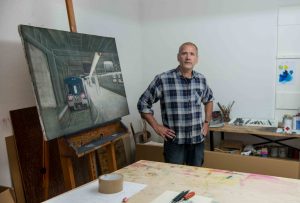
Martin Wolf, born in 1964, graduated from the Free University of Berlin with a degree in media studies and psychology and a doctorate in sociology. He studied art history and painting at the College of Education in Heidelberg.
In the 1980s, he developed his inclination towards realism as a painting style while a guest student in drawing courses at the Hochschule der Künste art school in Berlin. Renowned representatives of American, Dutch, French and German realism were contributing influences on his viewpoint. Martin Wolf succeeds in giving his pictures an individual touch not only by means of his own specific painting techniques. He calls his painting style “atmospheric realism”.
He has worked as a lecturer at several universities of applied sciences in Mannheim and Heidelberg, especially at the University of Technology and Design, and as an analyst at a bank. Since 2011, Martin Wolf has been active as a painter. In the age of globalisation, he looks for his subjects in his home country as well as in other European and non-European countries.
Urban landscapes / city portraits
The thematic field “urban landscapes” depicts excerpts from the “city” construct. The “Industrial Architecture in Mannheim” appears in the 2015 watercolour painting as a framework structure comprising verticals and horizontals.
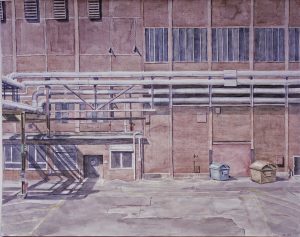
The viewer sees the façade of an industrial building covered with pipes and metal scaffolding. Dazzling light creates sharply defined shadows on the concrete square. Everything is clearly defined and conveys a certain order in the sense of control.
The city is a man-made living space, which in this instance appears to be far from natural. Industry guarantees the progress of man, who is a flawed being and who compensates for his inherent shortcomings in this way.
Further works of the thematic complex “Urban Landscapes” such as “The Suspension Bridge in Ludwigshafen” (2014),”Mannheim Skyline” (2012),”Marseilles” (2017),”Neckarauer Straße in Mannheim” (2014), NYC Manhattan – Garbage truck at night “(2012) and” Paris Boulogne, Passer-by “(2012) also deal with man’s artificially created habitat. The city is always a construct of lines and surfaces, a place of technology and industry, and an environment far removed from nature, in which people often seem to be lonely.
Martin Wolf’s meticulous representation and the staged light underline this artificiality within these works. The empty loneliness that is typical of the anonymity prevailing in modern cities is conveyed.
The thematic field of “city portraits” also ties in with this isolation within large cities. “Young man in Paris Metro”(2012),” Young couple in Paris Metro “(2012),” Paris Boulogne – House Façades “(2013),” University café Mannheim “(2012) and” University library Mannheim “(2012) are also concerned with the loneliness that can be experienced within a community.
Culture and Technology
The watercolours “Musée du Louvre – La Gioconda” from 2014 and “Greece – Delphi” from 2017 take up the theme of “culture and technology” and describe the discrepancy that can arise from this.
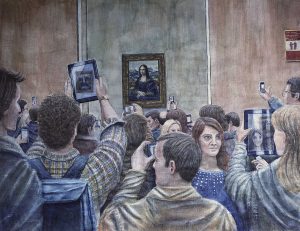
Leonardo da Vinci’s “Mona Lisa” smiles unwaveringly from her ancestral place in the Louvre museum, while a crowd of visitors scrambles in front of the famous painting. Everybody is taking pictures with cell phones and tablets. The ambiguity of the picture as an image and a portrait is brought to the fore.
What is in the foreground here? The portrait of Francesco del Giocondo’s wife, or the image of the world-famous painting?
The concept of culture is also questioned. It is the man-made world facing nature. How do we deal with culture? For example, how do we view art? Here technology takes the place of natural perception and reduces our perceptive forms to absurdity. The crowd is antithetically facing the unique “Gioconda”. The distinctiveness of the portrait illustrates the human endeavour to portray, depict and preserve oneself for posterity.
Martin Wolf holds a critical view of everyday situations. He questions them and pares them out into many layers, so that the viewer cannot avoid questioning his surroundings and himself.
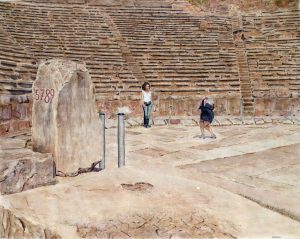
Nature and technology
Another work from the subject area “nature and technology” is the representation of the autumnal Palatinate forest, from 2015. The viewer is positively sucked into the sparse forest via a winding path. To the left and right of the path there is a tangled web of branches and tree trunks. The viewer is confronted with an invisible border: At the traffic sign “No entry for motorcycles and cars” he enters the natural space as a being without motorised resources, left to his own devices. The sign threatens to tip over and sink into its surroundings.
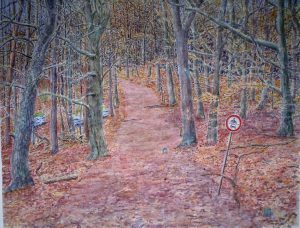
Detailed and meticulously accurate, but not photographically literal, reality seems to be depicted here in a lifelike way. The reality of the picture is felt and thoughtfully worked out before Martin Wolf captures it on handmade paper. It is thus not to be equated with actual reality. The atmosphere plays an important role and thus the composition is supported not least by the lighting. This is reflected in a selective choice of colours, which consists of restrained tones. The colour palette uses a precept that is especially compiled for the respective mood.
Other works in the thematic complex “nature and technology” are “Car dump in the South of France” (2014),”Lorry on Porquerolles” (2014),”Swimming over the Rhein in Mannheim” (2015),”The South of France – Networks I” (2015) and “The South of France – Networks II” (2015).
Text: Anastasia Schmidt M. A.

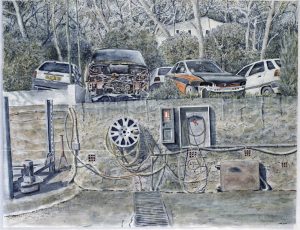
Exhibitions
2019
Solo exhibition, Eva-Wolf-Schliesser Gallery, Mannheim
2017/2018
Solo exhibition, Dr. Ebensberger’s practice, Heidelberg
2017
Solo exhibition, Eva-Wolf-Schliesser Gallery, Mannheim
2014
Solo exhibition, Schillerstrasse Gallery, Heidelberg
2013
Solo exhibition, Schillerstrasse Gallery, Heidelberg“Visual thinking more closely approaches unconscious processes than does verbal thinking, since it predates it.” (Sigmund Freud)

Martin Wolf, born in 1964, graduated from the Free University of Berlin with a degree in media studies and psychology and a doctorate in sociology. He studied art history and painting at the College of Education in Heidelberg.
In the 1980s, he developed his inclination towards realism as a painting style while a guest student in drawing courses at the Hochschule der Künste art school in Berlin. Renowned representatives of American, Dutch, French and German realism were contributing influences on his viewpoint. Martin Wolf succeeds in giving his pictures an individual touch not only by means of his own specific painting techniques. He calls his painting style “atmospheric realism”.
He has worked as a lecturer at several universities of applied sciences in Mannheim and Heidelberg and as an analyst at a bank. Since 2011, Martin Wolf has been active as a painter. In the age of globalisation, he looks for his subjects in his home country as well as in other European and non-European countries.
Urban landscapes / city portraits
The thematic field “urban landscapes” depicts excerpts from the “city” construct. The “Industrial Architecture in Mannheim” appears in the 2015 watercolour painting as a framework structure comprising verticals and horizontals.

The viewer sees the façade of an industrial building covered with pipes and metal scaffolding. Dazzling light creates sharply defined shadows on the concrete square. Everything is clearly defined and conveys a certain order in the sense of control.
The city is a man-made living space, which in this instance appears to be far from natural. Industry guarantees the progress of man, who is a flawed being and who compensates for his inherent shortcomings in this way.
Further works of the thematic complex “Urban Landscapes” such as “The Suspension Bridge in Ludwigshafen” (2014),”Mannheim Skyline” (2012),”Marseilles” (2017),”Neckarauer Straße in Mannheim” (2014), NYC Manhattan – Garbage truck at night “(2012) and” Paris Boulogne, Passer-by “(2012) also deal with man’s artificially created habitat. The city is always a construct of lines and surfaces, a place of technology and industry, and an environment far removed from nature, in which people often seem to be lonely.
Martin Wolf’s meticulous representation and the staged light underline this artificiality within these works. The empty loneliness that is typical of the anonymity prevailing in modern cities is conveyed.
The thematic field of “city portraits” also ties in with this isolation within large cities. “Young man in Paris Metro”(2012),” Young couple in Paris Metro “(2012),” Paris Boulogne – House Façades “(2013),” University café Mannheim “(2012) and” University library Mannheim “(2012) are also concerned with the loneliness that can be experienced within a community.
Culture and Technology
The watercolours “Musée du Louvre – La Gioconda” from 2014 and “Greece – Delphi” from 2017 take up the theme of “culture and technology” and describe the discrepancy that can arise from this.

Leonardo da Vinci’s “Mona Lisa” smiles unwaveringly from her ancestral place in the Louvre museum, while a crowd of visitors scrambles in front of the famous painting. Everybody is taking pictures with cell phones and tablets. The ambiguity of the picture as an image and a portrait is brought to the fore.
What is in the foreground here? The portrait of Francesco del Giocondo’s wife, or the image of the world-famous painting?
The concept of culture is also questioned. It is the man-made world facing nature. How do we deal with culture? For example, how do we view art? Here technology takes the place of natural perception and reduces our perceptive forms to absurdity. The crowd is antithetically facing the unique “Gioconda”. The distinctiveness of the portrait illustrates the human endeavour to portray, depict and preserve oneself for posterity.
Martin Wolf holds a critical view of everyday situations. He questions them and pares them out into many layers, so that the viewer cannot avoid questioning his surroundings and himself.

Nature and technology
Another work from the subject area “nature and technology” is the representation of the autumnal Palatinate forest, from 2015. The viewer is positively sucked into the sparse forest via a winding path. To the left and right of the path there is a tangled web of branches and tree trunks. The viewer is confronted with an invisible border: At the traffic sign “No entry for motorcycles and cars” he enters the natural space as a being without motorised resources, left to his own devices. The sign threatens to tip over and sink into its surroundings.

Detailed and meticulously accurate, but not photographically literal, reality seems to be depicted here in a lifelike way. The reality of the picture is felt and thoughtfully worked out before Martin Wolf captures it on handmade paper. It is thus not to be equated with actual reality. The atmosphere plays an important role and thus the composition is supported not least by the lighting. This is reflected in a selective choice of colours, which consists of restrained tones. The colour palette uses a precept that is especially compiled for the respective mood.
Other works in the thematic complex “nature and technology” are “Car dump in the South of France” (2014),”Lorry on Porquerolles” (2014),”Swimming over the Rhein in Mannheim” (2015),”The South of France – Networks I” (2015) and “The South of France – Networks II” (2015).
Text: Anastasia Schmidt M. A.


Exhibitions
2019
Solo exhibition, Eva-Wolf-Schliesser Gallery, Mannheim
2017/2018
Solo exhibition, Dr. Ebensberger’s practice, Heidelberg
2017
Solo exhibition, Eva-Wolf-Schliesser Gallery, Mannheim
2014
Solo exhibition, Schillerstrasse Gallery, Heidelberg
2013
Solo exhibition, Schillerstrasse Gallery, Heidelberg